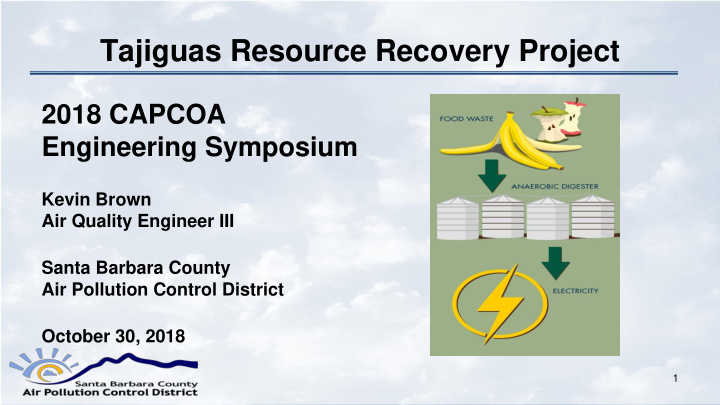



Tajiguas Resource Recovery Project 2018 CAPCOA Engineering Symposium Kevin Brown Air Quality Engineer III Santa Barbara County Air Pollution Control District October 30, 2018 1
Presentation Overview • Background • Process Description • Emission Controls • Permit Highlights • Project Challenges • Summary 2
3
Landfill Background • On the coast • Reaching capacity in the near future • Replacement landfill not finalized 4
Regulatory Background 5
Process Description 6
Process Streams 7
8
Materials Recovery Facility (MRF) • Tipping Area – Accepts 290,000 TPY combined waste • Materials Sorting Area – Recyclables – Organics – Residual waste • Paper Dryer 9
What is the Anaerobic Digestion Process? • Decomposition of waste in an oxygen-free environmental • Naturally occurs in the landfill • Process is sped up using percolate and creating an ideal environment • Byproduct is digester gas 10
Anaerobic Digestion Facility (ADF) • 16 heated, enclosed digesters • Dimensions: 100’ L x 22’ W x 16’ H • 710 ton capacity • 28 day digestion cycle • Video of Digester Operations 11
12
Combined Heat and Power Engines • Digester Gas CHP Engines: – Two GE/Jenbacher JMS 416 B82 engines – 1,573 bhp/1,141 kWe each • Landfill Gas CHP Engines: – Two GE/Jenbacher JMG 420 B82 engines – 1,966 bhp/1,429 kWe each • Electricity used for onsite needs or sold to the grid • Heat used for digesters or paper recycling 13
Compost Management Unit • Twenty- six 230’ L x 16’ W x 12’ H windrows • Cured six to eight weeks • Sold as commodity 14
15
Emission Controls 16
Baghouses • Used to control PM emissions from: – MRF tipping area – MRF sorting area – Paper dryer 17
Ammonia Scrubbers • MRF – Two crossflow scrubbers – Reduce odor • ADF – Crossflow scrubber – Reduce ammonia 18
Biofilters • Used to control VOC, PM, ammonia and odors from: – MRF tipping area – MRF sorting area – ADF • Size: 80 ’ L x 80’ W x 8 ’ H • Capacity: 50,000 cubic feet 19
Activated Carbon Filters • Used to reduce H 2 S concentration in biogas prior to combustion in the digester gas fired CHP engines 20
SCR/Oxidation Catalyst • Combined SCR and Oxidation Catalyst • Urea Injection • NOx and CO control • Equipped on the four combined heating and power engines 21
Enclosed Flares • Digester Gas Flare – John Zink ZTOF enclosed flare – 15.805 MMBtu/hr heat input rating – Downstream from Venturi scrubber to reduce ammonia concentration • Landfill Gas Flare – John Zink ZTOF enclosed flare – 39.000 MMBtu/hr heat input rating 22
Compost Best Management Practices • 20% dry woodchip blending • Turning every 2 weeks • 20 minute irrigation after turning • 50% to 60% moisture content • Video of Windrow Turner • Emission Factor Assumption for Digestate Compost 23
Permit Highlights 24
BACT/CEMS • BACT triggered for NO x , VOC, SO x , PM, PM 10 and PM 2.5 • Equipment subject to BACT: ADF, baghouses, CHP engines, enclosed flares, composting operations, and emergency electrical generators • Continuous Emissions Monitoring System (CEMS) and Data Acquisition System (DAS) for CHP engines 25
Offset Exemption • California Health & Safety Code §42314 – Produces 50 megawatts or less of electricity – Applies BACT – Emissions reductions from shutdown of existing equipment to be provided as emissions offsets – Provide reasonable available offsets from facilities it owns or operates – Made a good faith effort to secured reasonably available offsets 26
Permitted Emission Limits • Annual Potential to Emit for Project (TPY): NOx VOC CO SOx PM PM10 PM2.5 10.81 10.68 23.03 1.79 6.77 6.66 6.66 27
Project Challenges 28
HRA Modeling • Update model for District permit • Toxic emission factors lacking for digester gas • Will require toxic emission source testing at startup 29
Odors • Other waste conversion and composting projects have caused significant odor issues • This project has been designed with odor controls/mitigations 30
California Coastal Boundary • Original project within coastal zone boundary • Forced redesign of facility and supplemental EIR • Resulted in lawsuit and 2 year delay 31
Summary 32
Questions? 33
Recommend
More recommend